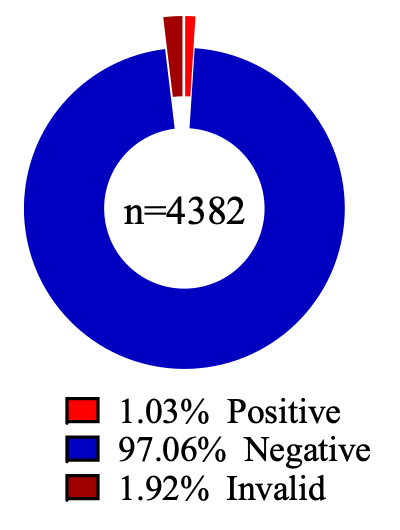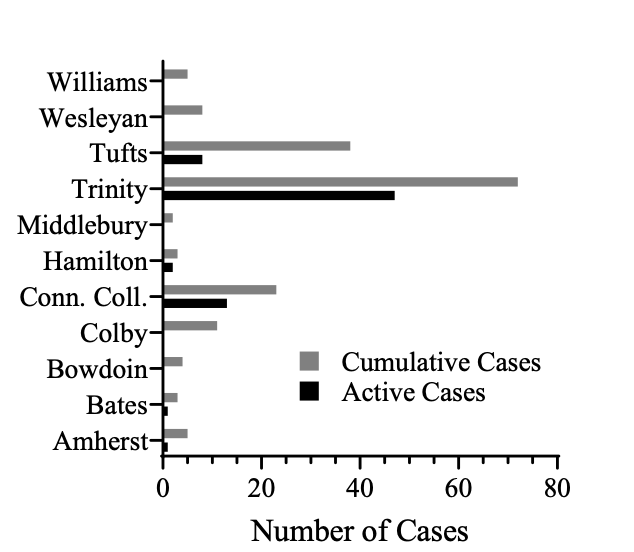Daniel J. Nesbitt ’22
Managing Editor
As of Monday, Oct. 12, Trinity has reported 47 active COVID cases within the student population with zero cases among employees and affiliates. This sharp increase in positive cases comes as a result of testing conducted for the week of Oct. 5, and during that time a total of 4,382 polymerase chain reaction (PCR) tests were conducted. A breakdown of this past week’s testing results is shown below.

Trinity’s COVID-19 positivity rate moved to 1.03% during the week of Oct. 5 as cases ticked higher in a growing outbreak. As of Monday, 47 positive cases had been reported and Trinity had surpassed its NESCAC peers in case totals by a significant margin. Photo courtesy of the Trinity Tripod.
During this time period, there were 45 positive and 84 invalid test results, for a positive test rate of 1.03% and an invalid test rate of 1.92%. Three of the positive tests are listed as “prior” which, according to the COVID dashboard “refer[s] to the test results of individuals who previously tested positive for COVID-19 and received another positive test result less than 90 days from the first.” It remains unclear how the College has identified 47 active cases with only 45 positive test results in the relevant time period. In the week prior (beginning Sept. 29), 4287 PCR tests were conducted with no positive results and an invalid test rate of 1.49%.
The Tripod compiled COVID testing data from all New England Small College Athletic Conference (NESCAC) schools to examine how Trinity fares with respect to the rest of the conference, both in terms of testing and current active cases. All the data comes from each respective schools’ publicly available COVID dashboard. Trinity’s dashboard is the only one dashboard. Trinity’s dashboard is the only one that is not updated immediately upon receipt of new test results.
In addition, every NESCAC school has chosen to partner with the Broad Institute of MIT and Harvard, thus all testing data comes from the same PCR assay allowing for comparison of test outcome rates without having to account for differences in the test itself. There are some shortcomings to the dataset that must be considered. First, the current in-person student, faculty, and staff populations are not readily available, so test outcomes cannot be analyzed in proportion to total on-campus individuals. Second, though six of eleven NESCAC schools require students be tested twice per week, one school tests three times per week, and the weekly testing protocol information was not readily available for four schools. Lastly, NESCAC schools began their testing protocols on varying dates, ranging from July 13 to Aug. 24, which could have an effect on the overall number of tests processed and the positive test rates.

Total number of active and cumulative COVID cases among NESCAC schools as of Monday Oct. 12. Trinity has the most active and cumulative cases with 47 and 72, respectively. With the exceptions of Tufts, Trinity, and Connecticut College, most NESCAC schools have relatively few COVID cases. Photo courtesy of the Trinity Tripod.
As of Monday, Oct. 12 at 7:00 pm EST, Trinity has 72 positive cases, the most of any NESCAC school. The number of active and cumulative cases at each school is shown below. Trinity leads the NESCAC in both active and cumulative COVID cases with 47 and 72, respectively. Tufts University has the second highest cumulative case total in the conference with 38, but only 8 active cases in isolation. Compared to Trinity’s positive test rate of 0.26%, Tufts’ positive test rate is just 0.04%.
Additionally, Tufts has performed more than three times as many tests as Trinity, possess a significantly larger testing population due to its various graduate schools and larger undergraduate population, and began testing approximately two weeks before Trinity. Connecticut College has the second highest active case total with 13 positive cases as of Monday, Oct. 12, however they only have 23 cumulative positive cases. Apart from Trinity, Tufts, and Connecticut College, all other NESCAC schools have 11 or fewer cumulative positive cases.
Trinity also has the highest positive test rate in the NESCAC with 0.26% of all tests performed returning positive results. Connecticut College has the second highest in the conference with 0.10%. The rest of the conference have positive test rates ranging between 0.01% and 0.04%. Of the five schools that report invalid test result totals, Trinity also has the highest invalid test rate with 1.49% of all tests conducted returning invalid results. Amherst, meanwhile, has an invalid test rate of 0.31%. Bowdoin, Colby, and Wesleyan have invalid test rates of 1.15%, 1.02%, and 1.07%, respectively.








+ There are no comments
Add yours